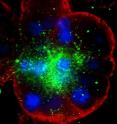Channeling efforts to fight cystic fibrosis
The lab of Kevin Foskett, PhD, the Isaac Ott Professor of Physiology at the University of Pennsylvania School of Medicine, has found a possible new target for fighting cystic fibrosis (CF) that could compensate for the lack of a functioning ion channel in affected CF-related cells. Their finding appears in the Journal of Clinical Investigation. The team explored the role of CFTR, the chloride ion channel mutated in CF patients, in fluid secretion by mucous gland cells. They used a recently developed transgenic pig model, in which the CFTR gene has been knocked out. The CFTR gene provides instructions for making a channel that transports negatively charged particles called chloride ions into and out of cells. The flow of chloride ions helps control the movement of water in tissues, which is necessary for the production of thin, freely flowing mucous.
CF researchers had been held back because existing animal models did not fully mimic the problems seen in people with CF. In people, faulty mucous glands may contribute to airway dehydration and the problems associated with CF. Mucous glands found in the airways of the lung are important to breathing because they help clear inhaled irritants and bacteria. They are also the sites where important macromolecules critical for lung defense against pathogens are made.
CF is the most common genetic disease in the United States, affecting about 30,000 children and adults and about 70,000 worldwide. The CF mutation makes certain organs of the body susceptible to obstruction due to thick mucus secretions, especially in the lung where thick secretions lead to chronic infections. This requires a daily regimen of drugs and physical therapy to help clear airway secretions.
"We discovered, first, that the ion transport and signal transduction mechanisms in the pig cells appear to be precisely the same as those used in human cells, indicating that the pig is an excellent model for studies of human lung function and a valuable tool for elucidating pathology of lung disease in CF," notes Foskett.
The team also discovered that fluid secretion by the mucous cells -- in response to neurotransmitters -- requires CFTR. This secretion was absent in the pigs lacking CFTR. However, the same cells that lacked the CFTR chloride ion channel, mimicking the condition in human CF, expressed another, different chloride ion channel that could be activated by elevating intracellular calcium by the same neurotransmitters. The presence of both channels in the same mucous cells suggests that the calcium-activated chloride channel could be targeted therapeutically to compensate for lack of CFTR functioning channels in CF-harmed cells.
"This crosstalk between the signaling pathways that activate the two different chloride ion channels now gives us a completely new therapeutic strategy to think about," says Foskett. For example, the presence of the calcium-activated chloride channel would enable CF mucous cells to secrete in response to stimulation that would have normally required the CFTR channel. Drugs that could enhance the magnitude of the calcium response might also enable activation of calcium-activated chloride channel-mediated secretion in CF cells. Importantly, such agents might be able to lead to secretion only during times of physiological stimulus, utilizing the appropriate neural regulation of secretion that likely remains intact in CF.
Source: University of Pennsylvania School of Medicine
Other sources
- Channeling efforts to fight cystic fibrosisfrom Science BlogFri, 17 Sep 2010, 20:56:15 UTC
- Channeling efforts to fight cystic fibrosisfrom PhysorgFri, 17 Sep 2010, 20:21:16 UTC
- Channeling efforts to fight cystic fibrosis: Crosstalk between ion channels points to new therapeutic strategyfrom Science DailyFri, 17 Sep 2010, 20:14:21 UTC
